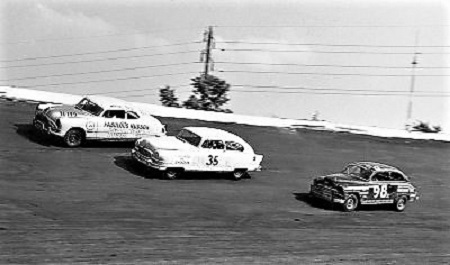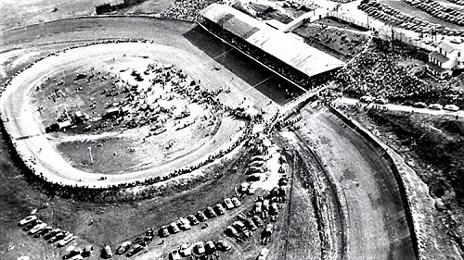DAYTON SPEEDWAY - DAYTON OH

The track was opened in June 1934 as a flat "D shaped" 5/8 mile dirt track. The first race was won by Ken Fowler of Paterson, NJ. Future three-time Indy 500 winner Mauri Rose of Dayton was second. In 1936, the entire track was repaved with asphalt and promised to be the fastest track of its design in the world. 1939 saw the track was converted to a high-banked 1/2 mile. The owner also raised the banking, twice; and may have buried old Trolley cars to help fill the space. The track was closed 1941-1945 due to World War II, but reopened in June 1946. It held the first “Big Car” race ever held at night on the East Coast (Ascot was first in the world). In 1950, NASCAR came to the facility for three seasons. It was the first Cup race ever
held on a paved track. The first ever Cup race was in June 1950. It was 200 laps around the 1/2 mile track. Jimmy Florian would win his first (and only) Cup event passing Curtis Turner and leading the final 32 laps. Linder would win three times in 1950; but would perish in a USAC Champ car racing accident at Trenton NJ in 1959. In 1951 NASCAR returned to Dayton for two races. Curtis Turner would win the first race by 3/4 of a lap over Dick Rathman. Fonty Flock would best Neil Cole by over a lap in the second visit for the season. 1952 would be the final year NASCAR visited Dayton. Both races saw Dick Rathman claim the win. The early race saw him beat Lloyd Moore by more than a lap. The tracks final race was increased to

300 laps, and Rathman just managed to edge Lee Petty by five seconds for thewin. The 1960's saw six feet removed from the banking and an infield scoring stand built. In 1975 a new grandstand was built and in 1979 the track was renamed "Greater Dayton Speedway" and the surface was repaved twice. In 1982, Front of the Concession Stand near turn one nearly collapsed between races one Sunday. The guardrails and restrooms were in disrepair and was closed at the end of season due to no liability insurance. In 1984 the track was up for sale and by the mid-80's the track began use as a landfill, eventually refuse filled the infield to the pavement on the straights. The site was then filled with clay and the track no longer exists.
All Photos copyright and are property of their respective owners
